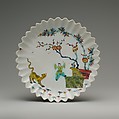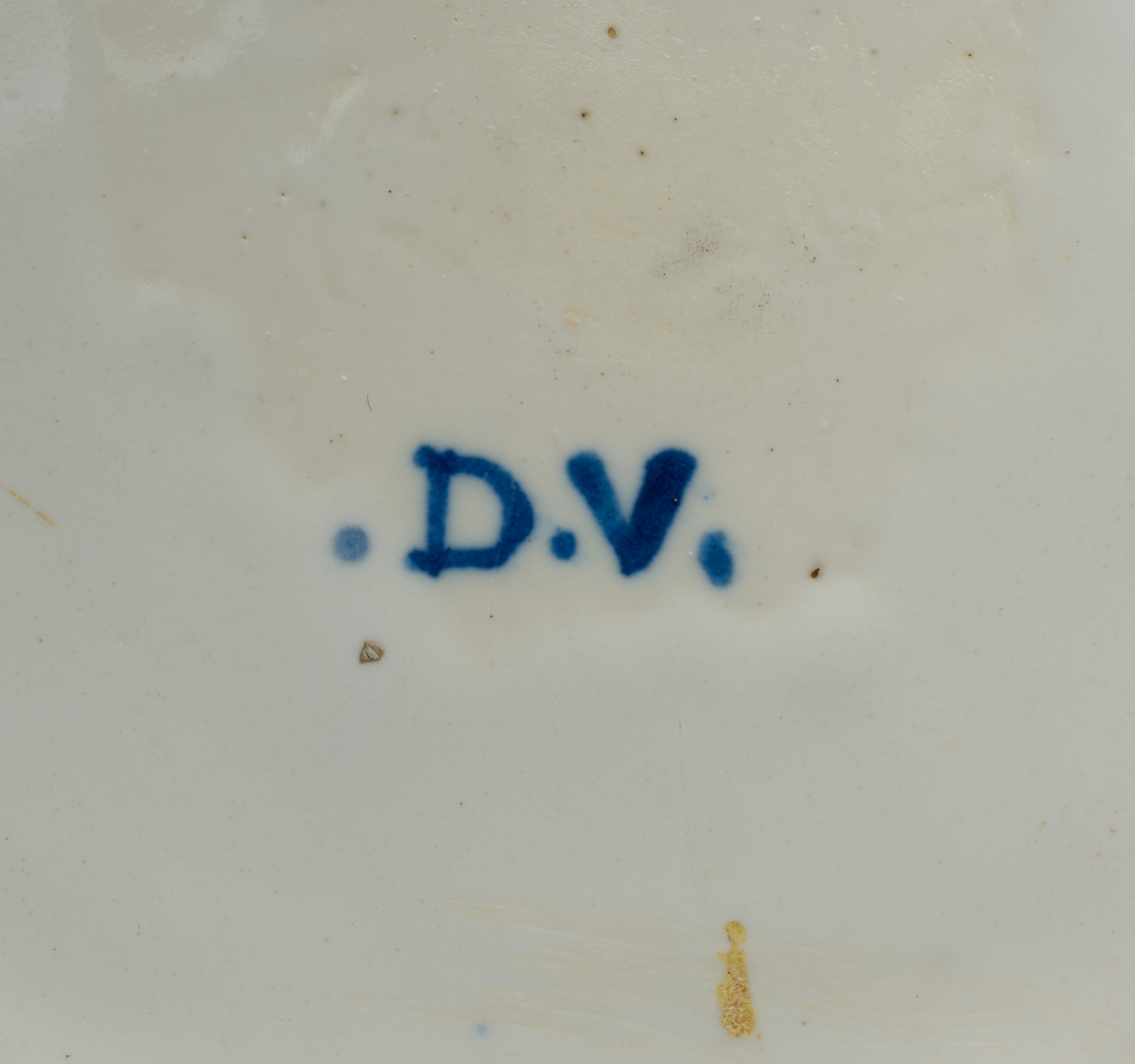Plate
Factory Villeroy French
Not on view
This dish is one of the relatively few surviving wares produced by the small ceramic factory established by a potter named François Barbin (French, ca. 1689–1765) in the hamlet of Villeroy, approximately twenty-five miles south of Paris, at some point in the years between 1734 and 1737. There is uncertainty as to the precise founding date of the factory, but contemporary documents indicate that in January 1737, Barbin was listed in the registers of the nearby parish of Mennecy as a “maker of faience and porcelain.”[1] As the son of a furniture maker in Paris, it is not clear how Barbin learned to produce either faience or porcelain, but as early as 1733 he describes his profession in precisely the same terms.[2] Barbin’s new factory was sited near the Château de Villeroy, the seat of François-Louis-Anne de Neufville (1695–1766), who became the fourth duc de Villeroy in 1734, and whose protection Barbin was eventually able to secure. Though Barbin’s factory produced both faience and soft-paste porcelain, its scale was small and only fifteen workers in total were employed during the relatively short time the factory was in existence.[3]
Given the size of the factory, it is not surprising that its production was modest in terms of both ambition and scale, and a large percentage of the surviving works from Villeroy are small figures, many of which reflect the then-current fashion for chinoiserie. Some of these figures are intended to represent lohans,[4] while others depict Chinese boys,[5] often attired in improbable clothing, but the thread that unites all of these figures is the intention to evoke an exotic, if little understood, Far East. The interest in Asian themes is also apparent in some of the wares produced at Villeroy. A feeding bowl in the Museum’s collection (see 54.147.8) is painted with chinoiserie figures, although the overall effect of the decoration is decidedly more European than Asian. A Villeroy glass cooler in a private collection[6] reflects the adaptation of Japanese Kakiemon motifs that were popular in Chantilly porcelain in particular at this time, and in this case, it appears in the depiction of young boys dressed in robes. The decorative scheme of a squirrel sitting on a banded hedge eating grapes, a motif frequently found on Japanese Kakiemon porcelain, decorates a Villeroy potpourri in the Musée des Arts Décoratifs, Paris.[7] A somewhat different example of Asian-inspired decoration is found on two glass coolers in the Cleveland Museum of Art, which are painted with scenes taken directly from prints by Jean-Antoine Fraisse (ca. 1680–1739), whose Le livre de desseins chinois (1735) was used by the painters at the Chantilly factory (see 50.211.121).[8]
A more direct dependence on Japanese ceramics is evident in this Villeroy dish. The molded fluting and the scalloped rim of the dish follow closely a model found frequently in Japanese Kakiemon porce-lain,[9] although the rim of Villeroy dish was created by cutting away the unfired clay rather than being formed in the mold, as would have been done with the Japanese examples. The painted decoration on the Villeroy dish is also derived from Kakiemon porcelains. The scene depicts a young boy standing near two banded hedges from which emerge branches of prunus (flowering plum) and bamboo, and a yellow tiger crouches off to one side. These last three motifs have their origins in Chinese art and represent some of the most popular and durable of all motifs used to decorate Chinese porcelains. Appropriated by Japanese potters, these motifs became mainstays of Kakiemon-style porcelains, and a Japanese example decorated in this manner may have served as the model for the potters at Villeroy.
A Japanese saucer dish with a similar composition painted in reverse, though without the boy, is in the Ashmolean Museum, Oxford,[10] and a particularly close comparison is offered by a Japanese dish with fluting, a scalloped rim, and the same composition, though again minus the boy, in the Musée Guimet, Paris.[11] This decorative scheme from Japanese Kakiemon porcelain became popular at the Meissen factory in Germany around 1730, and the so-called Yellow Lion decor was employed, with variations, on Meissen services made for the Saxon court at this time.[12]
Interestingly, the decoration on the Museum’s dish is most similar to the one that appears on a Chinese porcelain dish made for export, as all of the motifs found on the Museum’s example, including the boy, are incorporated, although it depicts three lions instead of one.[13] The appearance of this composition on Chinese porcelain is an indication of the popularity of the Japanese examples with these various motifs, and it reflects the adaptability of the Chinese potters to the demands of the export market. As Chinese export plates decorated in this precise manner appear to be rare, it is more likely that either a Japanese Kakiemon plate or a Meissen example served as the model at Villeroy, but it is unclear how Barbin might have had direct access to Japanese or German porcelain. Little is known about the degree of involvement of de Neufville in the affairs of the factory, but there is no evidence to suggest that he played an active role, such as making pieces of porcelain available to be copied, as is believed to have occurred at Chantilly.
The Villeroy dish is remarkably well painted for an early product of a small, experimental factory. As with most if not all of the soft-paste porcelain produced at Villeroy,[14] a tin glaze has been employed to provide a whiter surface for the enamel decoration than that provided by the slightly warm-toned paste used at the factory. The addition of tin to the lead-based glaze creates an opacity that is subtly different in appearance than the translucency of a typical lead glaze. Barbin eventually produced a soft paste of sufficient white-ness that a tin glaze was no longer necessary, but this occurred only after he closed the Villeroy factory in 1748 and established a new factory in nearby Mennecy in 1750.
Footnotes
(For key to shortened references see bibliography in Munger, European Porcelain in the Metropolitan Museum of Art. NY: The Metropolitan Museum of Art, 2018)
1 Dawson 1994, p. 48. The most comprehensive recent histories of the Villeroy factory are found in Le Duc 1987; Duchon 1988; Dawson 1994, pp. 48–50; Le Duc 1996, pp. 313–17; J.-G. Peyre 2000; Blaise 2001.
2 Duchon 1988, p. 11.
3 Le Duc 1987, p. 22.
4 Clare Le Corbeiller in Metropolitan Museum 1984a, p. 324, no. 301.
5 Le Duc 1996, p. 315.
6 Impey, Jörg, and Mason 2009, fig. 115.
7 Bertrand Rondot in Rondot 1999a, p. 207, no. 140.
8 Cleveland Museum of Art (1947.60). The painted decoration on these two coolers is unusually sophisticated and finely painted for Villeroy porcelain. Donna Corbin, Associate Curator, Philadelphia Museum of Art, who has catalogued these coolers, has suggested in conversation with this author that the decoration may have been executed outside of the Villeroy factory.
9 Impey 2002, p. 154, nos. 223–25; Cassidy-Geiger 2008, fig. 237.1.
10 Impey 2002, p. 132, no. 179.
11 Castelluccio 2013, fig. 53.
12 The closest Meissen parallel is found in Frühes Meissener Porzellan 1997, p. 125, no. 81. Similar Meissen examples, though without the fluting, are illustrated in Lessmann 2006, p. 40; Weber 2013, vol. 2, p. 290, fig. 46. The best known of the Meissen “Yellow Lion” decorative schemes is seen in a large dish illustrated in Cassidy-Geiger 2008, p. 440, no. 188.
13 Christie’s, London, sale cat., June 10, 1996, no. 272. It is possible that this is the same dish illustrated in Impey, Jörg, and Mason 2009, fig. 91; the caption for the photograph notes that the plate was decorated either in China or in the Netherlands. Another Chinese dish with this composition is illustrated in Nagatake 1977, ill. no. 84.
14 An egg cup in the British Museum made at Villeroy is described as having “a slightly milky lead glaze,” though it is noted that an analysis of the glaze indi-cates that it contains about 2 percent tin; Dawson 1994, pp. 49, 50, n. 1.
Due to rights restrictions, this image cannot be enlarged, viewed at full screen, or downloaded.
This artwork is meant to be viewed from right to left. Scroll left to view more.



